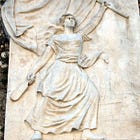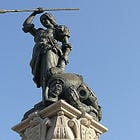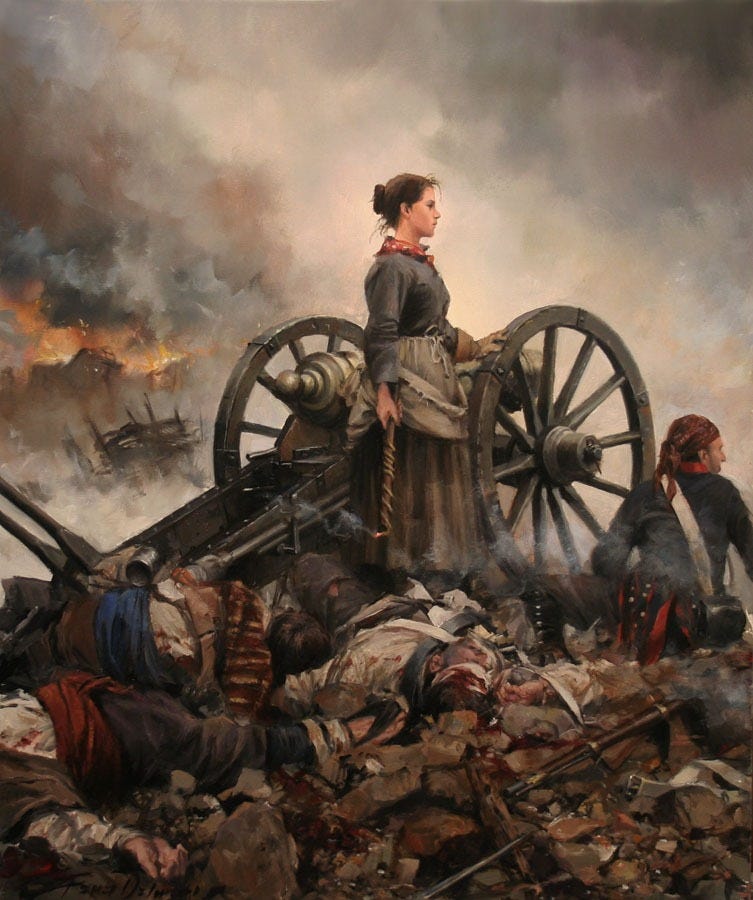The Resistance of Agustina de Aragón and the Birth of Spanish Nationalism
An essay on artistic depiction of sieges

I am a huge fan of siege art, and all my favorite painters know how to use fire. This exquisite scene has sparks in the background, a slow-burning matchcord on the linstock, and a flame in the belly of Agustina Raimunda María Saragossa Domènech, known as Agustina de Aragón. Spanish artist Augusto Ferrer-Dalmau Nieto portrays la artillera (the artillery woman) as a “handsome” young woman “of the lower class, about twenty-two years of age,” the description of historian Robert Southey in 1823.1
When Napoleon deposed Ferdinand VII and the Bourbon dynasty in 1808, Agustina de Aragón had been married to Juan Roca, a lieutenant in the First Artillery Regiment, for five years. Roca was one of many officers who refused to follow the orders of superiors collaborating with Napoleon, joining the nascent rebellion in the Spanish countryside instead. “He fought with the insurgents in western Catalonia, participating in key battles at El Bruch, María, and Belchite in June and July,” writes John Lawrence Tone.2
“Agustina, not content to remain in French-occupied Barcelona with their four-year-old son, also headed west, into guerrilla country.”
She did not stay long in the field: with a child in tow she could hardly campaign. But word had reached her ears about an uprising in Zaragoza, and so she headed for the Aragonese capital, never realizing that she was heading into one of the bloodiest sieges in history.
During a French assault on the Portillo gate, where a heavy cannon was positioned to fire grapeshot, Agustina “arrived at this battery with refreshments, at the time when not a man who defended it was left alive, so tremendous was the fire which the French kept up against it,” in Southey’s telling. French troops were advancing on the loaded, but unmanned, cannon. “For a moment the citizens hesitated to re-man the guns; Agustina sprung forward over the dead and dying, snatched a match from the hand of a dead artilleryman, and fired off a six-and-twenty pounder; then, jumping upon the gun, made a solemn vow never to quit it alive during the siege” (emphasis added). As a result of her inspiring example, “the French were repulsed here, and at all other points, with great slaughter.”
Previously in this series, available to premium subscribers:
It is a great story, too good to be entirely true. Agustina de Aragón became a legend in her own time because her story was sensationalized immediately and promoted as wartime propaganda. Napoleon’s war in Spain was seen as the fractious birth of Spanish nationalism, much as the exportation of French revolutionary fervor did the same for Italy and Germany, though in different ways. Agustina was courageous, to be sure, yet she was not unique in European warfare. On the contrary, Agustina became an instant hit because she fit an already-existing archetype of civic resistance by women that had developed across Atlantic Europe, the most siege-dense region of the world, since the Middle Ages.
To date, my study of siege art has not located a standalone volume on this topic in military history. Agustina lived at the precipice of 19th century feminism, but she was not resisting men. She was resisting Frenchmen. The women of Spain followed her example, but then English and Spanish men inflated her legend in pursuit of their own ends. Known for hyper-realism, Ferrer-Dalmau has hit the mark, in my estimation: his subject has just done her brave deed. The lies have not begun to accrete onto her legend yet. His heroine is the real heroine, not the legend of the heroine.
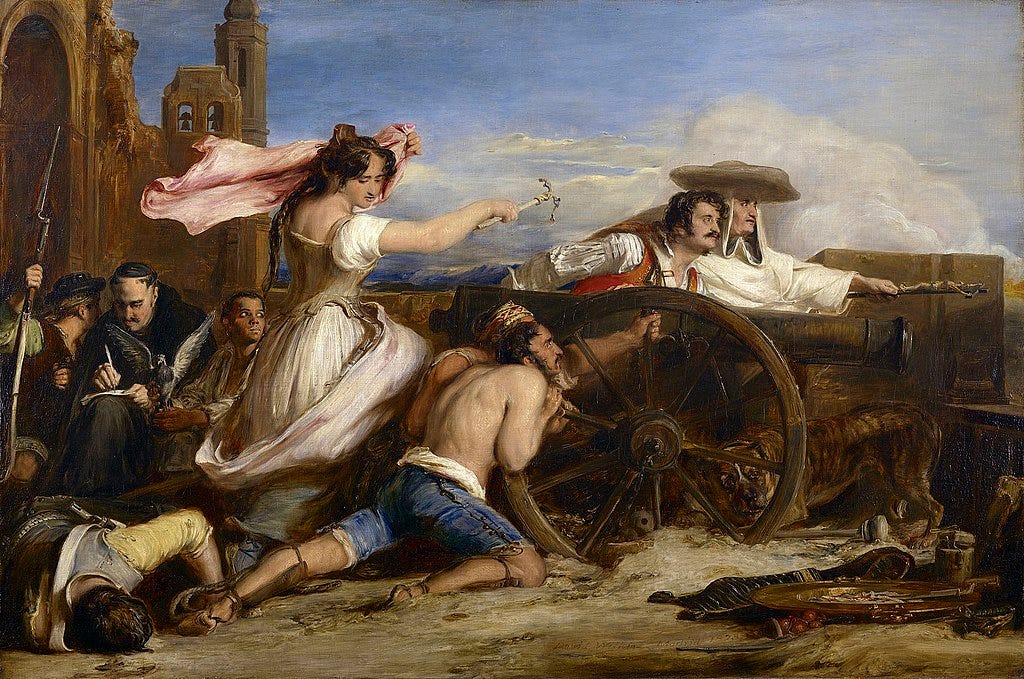
As a general rule, the longer the speech given under enemy fire, the less faith we should invest in the account. The lies about Agustina began with José Palafox, commander of the city’s defense, who declared her courage “superior to all [women] whom history has recorded” upon learning of her deed. Writing his memoirs soon after the final defeat of Napoleon, Palafox claimed that a fallen artilleryman at the Portillo gate had been her fiancé, and that Agustina had declared “I am here to avenge you” as she fired the cannon.
“The problem is that Palafox made up this story,” Tone writes. Palafox started this reputational inflation after the first siege of Zaragoza by naming her an artillery captain and authorizing her to wear a uniform coat with an epaulette. When the French returned with greater force and determination in December, Palafox used her example to rally the women of the city to its defense. On 30 January, after the French opened their bombardment, “Palafox issued a proclamation calling on women to fight alongside the men.”
“The French soldiers will be frightened of you, ashamed of defeat at your hands.” Palafox declared. “Your sole presence intimidates the bravest. A woman, when she wishes, makes the strongest man tremble.” Fighting women emasculated French men. This was very different from the second day of the first siege, when “women, children and the elderly were ordered to remain at home when the French again attacked,” according to Ronald Fraser.3 Palafox had learned it was necessary to leverage the city’s entire population, regardless of class.
When this very first storming attempt failed, the French looked to their siege guns. Jean-Antoine Verdier arrived on 27 June and opened his preparatory bombardment three days later. “It was to last uninterrupted for nearly 27 hours.” During the infantry asault that followed the bombardment, “the danger was greatest at the Portillo gate where fifty defenders had been killed or wounded,” Fraser writes. He dramatizes the scene thusly, emphasis added:
The last gunners alive, who were working frantically to set their huge 24-pound cannon, saw the line of French infantry, with fixed bayonets, advancing at the double, and fled. At that moment, a young woman who was bringing drink to the gunners, sprang forward, seized the still smouldering linstock from the hands of a dying artilleryman, and fired the cannon, which was loaded with grapeshot: the carnage among the closely packed French infantry was devastating. Standing on the gun carriage the woman rallied the civilian defenders to the gate’s defense; and they poured musket fire into the French who wavered and then turned in retreat.
Unlike Southey, who narrates Agustina apparently leaping upon a hot gun barrel, Fraser has the sense to place her on the gun carriage. It is still the same basic scene, and all it really requires of Agustina is to light the fuse on a cannon that has already been loaded and aimed for her by men. Still, Lord Byron was impressed, supposing that she had broken the boundaries of possibility. Before he had his famous affair with Mary Wollstonecraft Godwin, Byron framed Agustina as a free-love proto-feminist wielding a dagger (“anlace”).
Is it for this the Spanish maid, aroused,
Hangs on the willow her unstrung guitar,
And, all unsexed, the anlace hath espoused,
Sung the loud song, and dared the deed of war?
And she, whom once the semblance of a scar
Appalled, an owlet’s ‘larum chilled with dread,
Now views the column-scattering bayonet jar,
The falchion flash, and o’er the yet warm dead
Stalks with Minerva’s step where Mars might quake to tread.4
Francisco José de Goya y Lucientes, remembered as Goya, was the foremost Spanish artist of the era. “Women figure in the dualistic role of vengeful furies and victims” in his art depicting the war, Fraser observes: Goya’s Spanish women are fighters, but also subjects of rape and murder. Goya has Agustina climbing on a pile of corpses to reach the fuse. “Que Valor!” (What valor!) Goya captions his depiction of Agustina in his 1820 print collection, Los desastres de la guerra. She is the only recognizable person in the book. Attrition is normal in urban conflict; the dead under her feet are undifferentiated meatsacks.
Agustina was thus minted as a Spanish Joan of Arc in her own time. Indeed, Palafox “had two medals struck in her honor,” Tone writes. “One read ‘Defender of Zaragoza’ and the other read ‘Award for Valor and Patriotism’. He authorized Agustina to wear a uniform with these medals on her chest.” Agustina continued to wear her uniform coat after she left Iberia to “live with her daughter in a garrison town in Spanish North Africa,” Tone writes. “She died at age 72” in Cueta.
Writing in the 21st century, Tone thinks that 19th century men de-feminized her to reduce the status threat to their manhoods. “The liberating potential of revolutionary warfare was written out of Agustina’s tale. As a threatening symbol of female citizenship, she was neutralized,” he declares. Agustina’s decision to retire on the Spanish frontier of Africa makes sense to Tone as an escape from her assigned gender role. “Perhaps, at that remove, in a rough place, Agustina was more comfortable, more acceptable.” It all makes sense if we just ignore everything Agustina actually did between 1808 and her death in 1857, such as having a daughter, and buy into the legendary Agustina invented by men instead.
As the French returned to Zaragoza before Christmas, the city was full of typhus cases, including Agustina. “When the city capitulated in February 1809, almost no one remained alive capable of fighting,” while Agustina “was sick and in bed, and that is where the French found her.”
Recognizing her, they roughly took her prisoner, despite the fact that she was near death and had to care for her ill four-year-old son besides. The French shipped Agustina north through Navarre with other political prisoners for internment in France. The ordeal of the forced march killed her son. Once he was gone, however, Agustina was free to make her escape, which she accomplished with the aid of a Navarrese woman.
Reunited with her husband, Agustina had another child. When Juan Roca died in 1824, she remarried and had another child, though the second marriage split later over political opinions. This form of resistance is not enough for Tone. “In the equally dramatic siege of Gerona, the Spanish commander eventually formed four companies of women defenders,” he reports. “She served in a military capacity for several years, handling artillery in the defense of Tortosa, fighting in two guerrilla bands, and taking part in the battle of Vitoria in 1813, which ended Napoleon’s aspirations in Spain.” Somewhere by the end of this list, we have reached layers of 19th century mythmaking: the legend of Agustina de Aragón, not the historical woman.
One example shall suffice. Nick Lipscombe has written the most exhaustive modern work on the Battle of Vitoria. Agustina is not mentioned, for the story that she commanded a battery at the behest of the Duke of Wellington is unsupported by British records.5 Lipscombe’s book is in fact an argument that Wellington deprecated to work of his artillery officers out of class prejudice, therefore not a scrap of text left to us from the British artillerymen has escaped his notice. Her fame had reached the British Isles already, so her presence would have been notable, and noted. Instead, it is entirely unremarked.
Following after Southey, John Tone describes Agustina as a harridan of battle. “She harangued the men, even as she succored them: ‘Courage men,’ she said. ‘If you cannot go on, we women will.’” Emasculation matters most in both French and Spanish, in Tone’s telling. “The message was double-edged, encouraging the men, but also challenging their masculinity in a way calculated to inspire their sacrifice.”
Tone is on the mark, however, when he writes that “Agustina was the most famous example of a larger phenomenon: Spanish women resisted the occupation in ways that shocked and confounded the French and inspired admiration among other Europeans struggling under French rule.” Indeed, her example stands out because it is celebrated, whereas countless other women fought and died from the outbreak of the insurrection, but they are not as memorialized. Agustina became their propaganda avatar.
Violence began on 2 May 1808 in Madrid. “Early in the rising” an eyewitness “encountered in the streets close to the palace ‘a tall, well-built, twenty-five to thirty-year-old woman waving a white handkerchief and crying discomposedly, Arms! Arms’!” Ronald Fraser writes. “The women gathered at the Toledo gate to form barriers to the oncoming cavalry, dismounted a few cavalrymen, stabbing their horses, before being ridden down by the mass of horsemen.” Fighting in a city park took the life of Clara del Rey, “a forty-two year-old mother of five” who “was killed serving the cannons” along with her husband and their three sons.
Irrespective of social status, women played a notable role in the fighting. They ranged in age from adolescents to sixty-year-olds — the mean age of those killed was thirty-four. Thus half their numbers were, in terms of contemporary life expectancy, already middle aged or elderly. Their high casualty rate — eleven percent of the total inflicted although their proportion of the combatants was only just over seven percent — can only be explained by their bravery.
When the French punished Madrid in the aftermath of the uprising, two women were among thirteen noncombatants killed by firing squad. Fraser notes that the first provincial risings track the spread of Gazeta de Madrid across Spain. Accounts of women resisting the French, and sacrificing their lives, were printed alongside the news of the Bourbon abdications.
Zaragoza began their uprising three weeks after the uprising in Madrid. The city walls were unimproved adobe; they existed only to enable taxation of goods at the city gates. When the French showed up, however, “the greater part of the people rallied to make good their earlier deficiency, hurriedly dragging cannon to the southern walls’ three major gates, and opening musket loopholes in the walls.” Women did much of this labor. Women also gathered scrap metal to make ammunition, reloaded muskets so that men could maintain a high rate of fire, made bandages, carried food and drink. Eyewitness Alcade Ibieca wrote that “the street to the Carmen gate was thick with people, most of them armed, and among them, women, old men, and boys.” Decades after the siege, Spanish historian Gómez de Arteche quipped: “Those women were great men.”
“Women of all ranks assisted” in the defense emergency, Southey reports. Women “formed themselves into companies, some to relieve the wounded, some to carry water, wine, and provisions, to those who defended the gates.” The courage that Agustina de Aragón displayed was far from unique. Women of all classes in the city participated in the popular resistance of their community.
The Countess Burita instituted a corps for this service; she was young, delicate, and beautiful. In the midst of the most tremendous fire of shot and shells, she was seen cooly attending to those occupations, which were now become her duty; nor throughout the whole of a two months’ siege did the imminent danger, to which she incessantly exposed herself, produce the slightest apparent effect upon her, or in the slightest degree bend her from her heroic purpose. Some of the monks bore arms; others exercised their spiritual offices to the dying; others, with the nuns, were busied making cartridges which the children distributed.
“In siege warfare and in wars of occupation, where front lines run through plazas, houses, and churches, women have more opportunities to fight, and the women of Spain made the most of their chance,” Tone writes. Civic resistance is the first step towards national resistance, which requires total commitment of society, including women, because women live inside the community that is defending itself. “They were the soul of Zaragoza’s defense,” Tone writes, but in practical application, women were the logistical and combat support backbone first, combat auxilliaries second, and only by necessity.
Agustina stepped forward in a moment when no men were available or willing to finish the job of firing the cannon. “In Agustina’s account, the French suddenly hit the defenders at the Portillo gate with an explosive shell,” Fraser writes. “The blast took down everyone and cleared the way for an assault. Seeing the situation, Agustina picked up a lit fuse, climbed through the dying and wounded men into the breach, and fired a cannon loaded with shot at point blank range into the advancing French” (emphasis added). The entire rest of the job had already been done for her, by men.
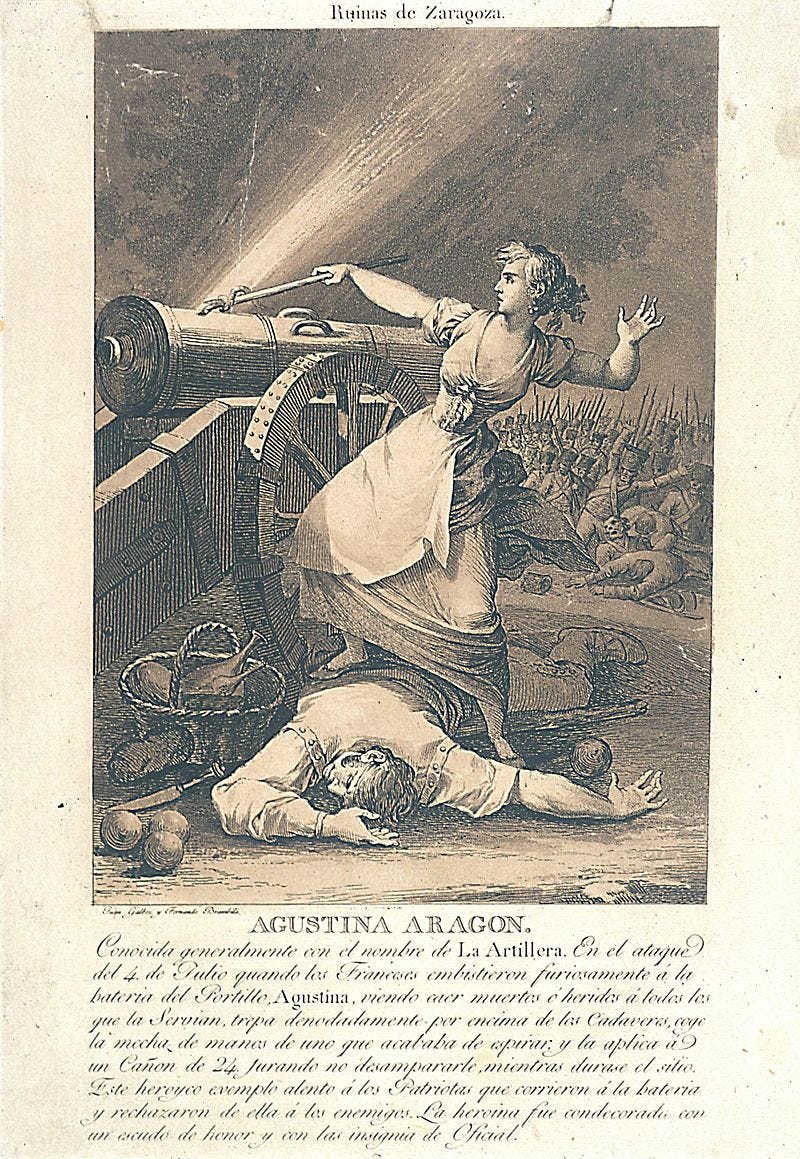
Facing danger, a common woman had enough courage to step forward and light a cannon fuse. That is not nothing — the difference between a hero and a coward is a single moment of action — but it is just one thing that one woman did, in a whole city full of women who took part in the battle for the gates in thousands of ways. To do this one thing, Agustina supposedly had to stand on the bodies of dead men. The taller the pile of corpses, the less we should credit the realism of the imagery. Bodies do not actually ‘stack up,’ in the real world.
In reality, Agustina and the women of Zaragoza looked to the bodies of living Spanish men to resist France. According to Ronald Fraser, after their city fell in 1809, the women of Zaragoza started families. Marriages were “an all-time high for the new century” in 1810, while births “were ten percent above average. Despite its two sieges, Zaragoza was one of the few places where at the end of the war the population had grown by nearly two percent since the conflict’s start, and eighteen percent above its 1800 figure.”
Women across Spain also reacted to the occupation with their wombs, though their reactions were mostly the opposite of Zaragozan women. “In Guipúzcoa, the Basque province adjoining the French border and through which the main Paris-Madrid road passed, the incursion of imperial troops was accompanied by a sudden drop in conceptions during the first three months of the year” 1808, Fraser writes. “Marriages dropped sharply, as young betrothed, widows and widowers, postponed or cancelled their weddings throughout the region” of Castille.
Far from emasculating men, the female defenders of Zaragoza — including Agustina de Aragón — seem to have stood out by marrying them and having children after the siege. Like other women of Spain, however, they denied sex to the occupiers. “French veterans of the Spanish war who had fought in other campaigns noted that Spanish women obstinately refused to offer affection, romance, and sexual intercourse, in contrast to the collaboration offered by women in Germany, Austria, and elsewhere.” It was one of the conditions that made the Peninsular War so harsh in French memory.
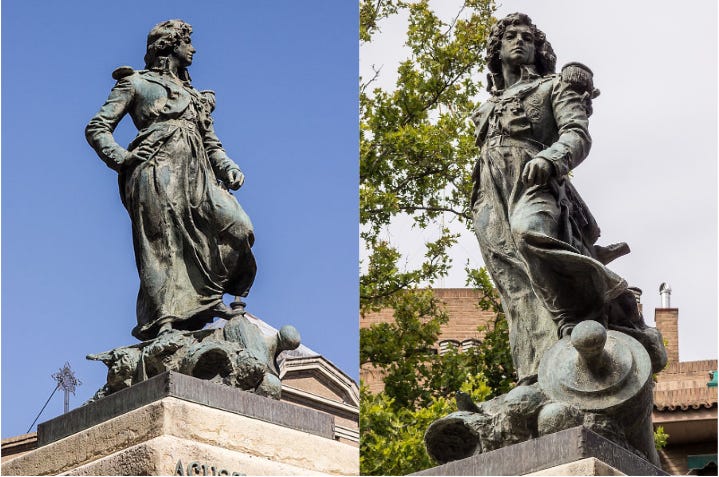
“Agustina’s tale illustrates the way in which war — especially a war of occupation — can create an opportunity for women openly to proclaim their patriotism. Indeed, for historians of women and gender, it is worth systematically exploring the chaos of occupation and resistance … as scenes of liberation from gender norms,” Tone writes, oblivious to all the gender norms.
Gender norms only exist for shaming toxic men, you see. “In 1898,” Tone observes, “the courage of the women of Zaragoza was extolled to shame Spanish men into shedding their ‘last drop of blood’ for national glory in Cuba. Santiago, however, was not Zaragoza, and the public campaign comparing the two was not notably effective.” Shaming men is not necessarily a notably effective way to motivate them to risk their lives for the nation, who could have guessed?
The myths of Agustina de Aragón are man-made. They are products of male historians displaying a fetish for the inversion of sex roles in the image of a woman firing a cannon. Adopting the fanciful telling of José Palafox, Byron rationalized her resistance as a sexual expression. Agustina had become the herald of Victorian-era sexual tensions:
Her lover sinks — she sheds no ill-timed tear,
Her chief is slain — she fills his fatal post,
Her fellows flee — she checks their base career,
The foe retires — she heads the sallying host.
Who can appease like her lover’s ghost?
Who can avenge so well a leader’s fall?
What maid retrieve when man’s flushed hope is lost?
Who hang so fiercely on the flying Gaul,
Foiled by a woman’s hand, before a battered wall?6
Agustina de Aragón was hardly the first woman ever noted for defending her city, even in Spain, though the pattern began in France. Sister Geneviève saved Paris from Attila. An all-female team of artillerists reputedly operated the mangonel (catapult) which killed Simon de Montfort during the siege of Toulouse in 1218. Later in the same century as Joan of Arc, Jeanne Laisné aka Jeanne Hachette defended Beauvais from Charles the Bold. The combined powers of the gunpowder cannon and the printing press made Catherine Ségurane into another French national heroine even though she was resisting Turkish invaders sent by a French king. María Pita became the first modern Spanish example at Coruña in 1589. Agustina was not a new kind of woman in the world, whatever men say.
In siege battles, there are always women, and there is always fire. Both should be expected and understood as normal, natural elements of the scene. Cities contain communities that can rise to their common defense. Women provide support to the men who fight, and in moments of extreme need, step into the breach themselves to defend their community and country. Such women are not men, or manly women. They are very brave women who deserve to be remembered for their real courage, which is simply a character trait of human beings, and not a trait specific to a sex.
More Siege Paintings Should Have Fire
No, not the time when the ghost of Peter the Great drove Russian expansion under his niece, Anna Ioannovna. The other time, when Catherine the Great resumed the Russian imperial project in the Black Sea. American naval captain John Paul Jones took part as a rear admiral in the Russian Navy to cover the landings. Yes, the time when the Ottoman empire los…
Southey, Robert. History of the Peninsular War. London, 1823.
Tone, John Lawrence. “A Dangerous Amazon: Agustina Zaragoza and the Spanish Revolutionary War, 1808-1814.” European History Quarterly, Vol. 37, Issue 4, Oct 2007, pp. 499-646.
Fraser, Ronald. Napoleon’s Cursed War: Spanish Popular Resistance in the Peninsular War, 1808-14. Verso, 2023.
Byron. Childe Harold's Pilgrimage: A Romaunt, Canto I, verse LIV. 1812.
Lipscombe, Nick. Wellington's Guns: The Untold Story of Wellington and his Artillery in the Peninsula and at Waterloo. Osprey Publishing, 2013.
Byron, Canto I, verse LVI.



